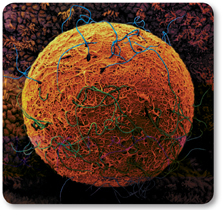34.4 Fertilization and Development
 What takes place during fertilization and the early stages of human development?
What takes place during fertilization and the early stages of human development? What important events occur during the later stages of human development?
What important events occur during the later stages of human development?
zygote • blastocyst • implantation • gastrulation • neurulation • placenta • fetus
Flowchart As you read, draw a flowchart that shows the steps from fertilized egg to newborn baby.
THINK ABOUT IT Of all the wonders of the living world, is there anything more remarkable than the formation of a new human being from a single cell? In a sense, we know how this happens. The embryo goes through round after round of cell division, producing the trillions of cells in a newborn baby. Simple enough, it seems. But how do these cells arrange themselves so beautifully into the tissues and organs of the body, and how does an individual cell “know” to become an embryonic skin, heart, or blood cell? These are some of the most important questions in all of biology, and we are only beginning to learn the answers.
Fertilization and Early Development
 What takes place during fertilization and the early stages of human development?
What takes place during fertilization and the early stages of human development?
The story of human development begins with the gametes—sperm produced in the testes and egg cells produced in the ovaries. Sperm and egg must meet, so that the two gametes can fuse to form a single cell. With this single cell, the process of development begins.  The fusion of a sperm and egg cell is called fertilization.
The fusion of a sperm and egg cell is called fertilization.
Fertilization During sexual intercourse, sperm are released when semen is ejaculated through the penis into the vagina. Semen is generally released just below the cervix, the opening that connects the vagina to the uterus. Sperm swim actively through the uterus into the Fallopian tubes. Hundreds of millions of sperm are released during an ejaculation. If an egg is present in one of the Fallopian tubes, its chances of being fertilized are good.
The egg is surrounded by a protective layer that contains binding sites to which sperm can attach. The sperm head then releases powerful enzymes that break down the protective layer of the egg. The haploid (N) sperm nucleus enters the haploid egg, and chromosomes from sperm and egg are brought together. Once the two haploid nuclei fuse, a single diploid (2N) nucleus is formed, containing a single set of chromosomes from each parent cell. The fertilized egg is called a zygote. At this point the developing human can also be called an embryo.

FIGURE 34–17 Sperm Meet Egg Many sperm usually reach an egg, but only one sperm can successfully break through the egg's protective barrier (SEM 650×).

Table of Contents
- Formulas and Equations
- Applying Formulas and Equations
- Mean, Median, and Mode
- Estimation
- Using Measurements in Calculations
- Effects of Measurement Errors
- Accuracy
- Precision
- Comparing Accuracy and Precision
- Significant Figures
- Calculating With Significant Figures
- Scientific Notation
- Calculating With Scientific Notation
- Dimensional Analysis
- Applying Dimensional Analysis




